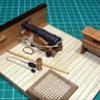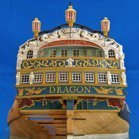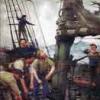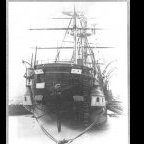Supplies of the Ship Modeler's Handbook are running out. Get your copy NOW before they are gone! Click on photo to order.
×
-
Posts
7,982 -
Joined
-
Last visited
Reputation Activity
-
 Louie da fly got a reaction from mtaylor in La Lomellina by Louie da fly - scale 1:100 - Theoretical Reconstruction of a Genoese carrack sunk in 1516
Louie da fly got a reaction from mtaylor in La Lomellina by Louie da fly - scale 1:100 - Theoretical Reconstruction of a Genoese carrack sunk in 1516
I always felt that way about Italian. Look at the way "non piu andrai" from Mozart's Marriage of Figaro is sung . . . sounds like 'non pyandrai' https://www.youtube.com/watch?v=e1-FKyOTvto
And just relax and enjoy the music. Love it.
Steven
-
 Louie da fly got a reaction from JacquesCousteau in To weather or not to weather...?
Louie da fly got a reaction from JacquesCousteau in To weather or not to weather...?
I've done both. My earlier models were 'pristine', but I have been slowly teaching myself to weather my wooden models. Some people are masters of weathering - have a look at RGL's wonderful (plastic) warships - his Dreadnought, Heian Maru etc. And somewhere on the forum there's a Russian battleship of his from the Battle of Tsushima which I can't find (unfortunately) - it's amazing!
Here's a bit of my own weathering - a 12th century Mediterranean merchant ship that doesn't get a lot of TLC - the owners are more interested in immediate profits than maintenance. And yes, I have enough figures on board for a full crew. I carved them from pear wood - scale 1:75 . I've perhaps been a bit cautious about applying the weathering - better than too much. Still learning, and learning how to shade the figures so they don't look like they're model railway figures straight out of the box.
Steven
-
 Louie da fly got a reaction from GrandpaPhil in La Lomellina by Louie da fly - scale 1:100 - Theoretical Reconstruction of a Genoese carrack sunk in 1516
Louie da fly got a reaction from GrandpaPhil in La Lomellina by Louie da fly - scale 1:100 - Theoretical Reconstruction of a Genoese carrack sunk in 1516
I've been working on the other frames. Here's one from the bow - the French refer to the V-shaped piece at the bottom, charmingly, as a fourcat.
But I came to the conclusion that the shapes I'd worked out for the frames of the aftercastle and some for the bow were based on a wrong premise - I hadn't taken into account the evidence of contemporary pictures and had made them much too narrow, and quite a few of them will have to be either tossed or dramatically altered. The first pic below is the frame as made; the second is how wide it ought to be. I'm hoping I can at least salvage some of the futtocks, but I'm pretty sure the floor timbers will have to be ditched.
I eventually got sick of trying to figure out the frame shapes on paper from the lines I'd drawn up - every time I worked it out it was different. So I went a different way. Based on the sterns of carracks from contemporary representations from near the Lomellina's time,
I made a solid half-hull, going aft from the last frame I was happy with
Took very little time - a couple hours with a hand-saw and a rasp, once I'd decided to do it.
Next I'll be cutting this solid shape into slivers at 10mm ( a bit under half an inch) intervals - equivalent to every second frame - along the length of the keel, to get reliable shapes for the frames. Wish me luck!
Steven
-
 Louie da fly got a reaction from mtaylor in To weather or not to weather...?
Louie da fly got a reaction from mtaylor in To weather or not to weather...?
I've done both. My earlier models were 'pristine', but I have been slowly teaching myself to weather my wooden models. Some people are masters of weathering - have a look at RGL's wonderful (plastic) warships - his Dreadnought, Heian Maru etc. And somewhere on the forum there's a Russian battleship of his from the Battle of Tsushima which I can't find (unfortunately) - it's amazing!
Here's a bit of my own weathering - a 12th century Mediterranean merchant ship that doesn't get a lot of TLC - the owners are more interested in immediate profits than maintenance. And yes, I have enough figures on board for a full crew. I carved them from pear wood - scale 1:75 . I've perhaps been a bit cautious about applying the weathering - better than too much. Still learning, and learning how to shade the figures so they don't look like they're model railway figures straight out of the box.
Steven
-
 Louie da fly got a reaction from Cathead in La Lomellina by Louie da fly - scale 1:100 - Theoretical Reconstruction of a Genoese carrack sunk in 1516
Louie da fly got a reaction from Cathead in La Lomellina by Louie da fly - scale 1:100 - Theoretical Reconstruction of a Genoese carrack sunk in 1516
I've been working on the other frames. Here's one from the bow - the French refer to the V-shaped piece at the bottom, charmingly, as a fourcat.
But I came to the conclusion that the shapes I'd worked out for the frames of the aftercastle and some for the bow were based on a wrong premise - I hadn't taken into account the evidence of contemporary pictures and had made them much too narrow, and quite a few of them will have to be either tossed or dramatically altered. The first pic below is the frame as made; the second is how wide it ought to be. I'm hoping I can at least salvage some of the futtocks, but I'm pretty sure the floor timbers will have to be ditched.
I eventually got sick of trying to figure out the frame shapes on paper from the lines I'd drawn up - every time I worked it out it was different. So I went a different way. Based on the sterns of carracks from contemporary representations from near the Lomellina's time,
I made a solid half-hull, going aft from the last frame I was happy with
Took very little time - a couple hours with a hand-saw and a rasp, once I'd decided to do it.
Next I'll be cutting this solid shape into slivers at 10mm ( a bit under half an inch) intervals - equivalent to every second frame - along the length of the keel, to get reliable shapes for the frames. Wish me luck!
Steven
-
 Louie da fly reacted to druxey in La Lomellina by Louie da fly - scale 1:100 - Theoretical Reconstruction of a Genoese carrack sunk in 1516
Louie da fly reacted to druxey in La Lomellina by Louie da fly - scale 1:100 - Theoretical Reconstruction of a Genoese carrack sunk in 1516
A very pragmatic and practical approach to lofting! It should work out well.
-
 Louie da fly got a reaction from mtaylor in La Lomellina by Louie da fly - scale 1:100 - Theoretical Reconstruction of a Genoese carrack sunk in 1516
Louie da fly got a reaction from mtaylor in La Lomellina by Louie da fly - scale 1:100 - Theoretical Reconstruction of a Genoese carrack sunk in 1516
I've been working on the other frames. Here's one from the bow - the French refer to the V-shaped piece at the bottom, charmingly, as a fourcat.
But I came to the conclusion that the shapes I'd worked out for the frames of the aftercastle and some for the bow were based on a wrong premise - I hadn't taken into account the evidence of contemporary pictures and had made them much too narrow, and quite a few of them will have to be either tossed or dramatically altered. The first pic below is the frame as made; the second is how wide it ought to be. I'm hoping I can at least salvage some of the futtocks, but I'm pretty sure the floor timbers will have to be ditched.
I eventually got sick of trying to figure out the frame shapes on paper from the lines I'd drawn up - every time I worked it out it was different. So I went a different way. Based on the sterns of carracks from contemporary representations from near the Lomellina's time,
I made a solid half-hull, going aft from the last frame I was happy with
Took very little time - a couple hours with a hand-saw and a rasp, once I'd decided to do it.
Next I'll be cutting this solid shape into slivers at 10mm ( a bit under half an inch) intervals - equivalent to every second frame - along the length of the keel, to get reliable shapes for the frames. Wish me luck!
Steven
-
 Louie da fly got a reaction from thibaultron in To weather or not to weather...?
Louie da fly got a reaction from thibaultron in To weather or not to weather...?
I've done both. My earlier models were 'pristine', but I have been slowly teaching myself to weather my wooden models. Some people are masters of weathering - have a look at RGL's wonderful (plastic) warships - his Dreadnought, Heian Maru etc. And somewhere on the forum there's a Russian battleship of his from the Battle of Tsushima which I can't find (unfortunately) - it's amazing!
Here's a bit of my own weathering - a 12th century Mediterranean merchant ship that doesn't get a lot of TLC - the owners are more interested in immediate profits than maintenance. And yes, I have enough figures on board for a full crew. I carved them from pear wood - scale 1:75 . I've perhaps been a bit cautious about applying the weathering - better than too much. Still learning, and learning how to shade the figures so they don't look like they're model railway figures straight out of the box.
Steven
-
 Louie da fly got a reaction from PqLear in To weather or not to weather...?
Louie da fly got a reaction from PqLear in To weather or not to weather...?
I've done both. My earlier models were 'pristine', but I have been slowly teaching myself to weather my wooden models. Some people are masters of weathering - have a look at RGL's wonderful (plastic) warships - his Dreadnought, Heian Maru etc. And somewhere on the forum there's a Russian battleship of his from the Battle of Tsushima which I can't find (unfortunately) - it's amazing!
Here's a bit of my own weathering - a 12th century Mediterranean merchant ship that doesn't get a lot of TLC - the owners are more interested in immediate profits than maintenance. And yes, I have enough figures on board for a full crew. I carved them from pear wood - scale 1:75 . I've perhaps been a bit cautious about applying the weathering - better than too much. Still learning, and learning how to shade the figures so they don't look like they're model railway figures straight out of the box.
Steven
-
 Louie da fly got a reaction from BANYAN in La Lomellina by Louie da fly - scale 1:100 - Theoretical Reconstruction of a Genoese carrack sunk in 1516
Louie da fly got a reaction from BANYAN in La Lomellina by Louie da fly - scale 1:100 - Theoretical Reconstruction of a Genoese carrack sunk in 1516
I've been working on the other frames. Here's one from the bow - the French refer to the V-shaped piece at the bottom, charmingly, as a fourcat.
But I came to the conclusion that the shapes I'd worked out for the frames of the aftercastle and some for the bow were based on a wrong premise - I hadn't taken into account the evidence of contemporary pictures and had made them much too narrow, and quite a few of them will have to be either tossed or dramatically altered. The first pic below is the frame as made; the second is how wide it ought to be. I'm hoping I can at least salvage some of the futtocks, but I'm pretty sure the floor timbers will have to be ditched.
I eventually got sick of trying to figure out the frame shapes on paper from the lines I'd drawn up - every time I worked it out it was different. So I went a different way. Based on the sterns of carracks from contemporary representations from near the Lomellina's time,
I made a solid half-hull, going aft from the last frame I was happy with
Took very little time - a couple hours with a hand-saw and a rasp, once I'd decided to do it.
Next I'll be cutting this solid shape into slivers at 10mm ( a bit under half an inch) intervals - equivalent to every second frame - along the length of the keel, to get reliable shapes for the frames. Wish me luck!
Steven
-
 Louie da fly got a reaction from Siggi52 in La Lomellina by Louie da fly - scale 1:100 - Theoretical Reconstruction of a Genoese carrack sunk in 1516
Louie da fly got a reaction from Siggi52 in La Lomellina by Louie da fly - scale 1:100 - Theoretical Reconstruction of a Genoese carrack sunk in 1516
I've been working on the other frames. Here's one from the bow - the French refer to the V-shaped piece at the bottom, charmingly, as a fourcat.
But I came to the conclusion that the shapes I'd worked out for the frames of the aftercastle and some for the bow were based on a wrong premise - I hadn't taken into account the evidence of contemporary pictures and had made them much too narrow, and quite a few of them will have to be either tossed or dramatically altered. The first pic below is the frame as made; the second is how wide it ought to be. I'm hoping I can at least salvage some of the futtocks, but I'm pretty sure the floor timbers will have to be ditched.
I eventually got sick of trying to figure out the frame shapes on paper from the lines I'd drawn up - every time I worked it out it was different. So I went a different way. Based on the sterns of carracks from contemporary representations from near the Lomellina's time,
I made a solid half-hull, going aft from the last frame I was happy with
Took very little time - a couple hours with a hand-saw and a rasp, once I'd decided to do it.
Next I'll be cutting this solid shape into slivers at 10mm ( a bit under half an inch) intervals - equivalent to every second frame - along the length of the keel, to get reliable shapes for the frames. Wish me luck!
Steven
-
 Louie da fly got a reaction from firdajan in La Lomellina by Louie da fly - scale 1:100 - Theoretical Reconstruction of a Genoese carrack sunk in 1516
Louie da fly got a reaction from firdajan in La Lomellina by Louie da fly - scale 1:100 - Theoretical Reconstruction of a Genoese carrack sunk in 1516
I've been working on the other frames. Here's one from the bow - the French refer to the V-shaped piece at the bottom, charmingly, as a fourcat.
But I came to the conclusion that the shapes I'd worked out for the frames of the aftercastle and some for the bow were based on a wrong premise - I hadn't taken into account the evidence of contemporary pictures and had made them much too narrow, and quite a few of them will have to be either tossed or dramatically altered. The first pic below is the frame as made; the second is how wide it ought to be. I'm hoping I can at least salvage some of the futtocks, but I'm pretty sure the floor timbers will have to be ditched.
I eventually got sick of trying to figure out the frame shapes on paper from the lines I'd drawn up - every time I worked it out it was different. So I went a different way. Based on the sterns of carracks from contemporary representations from near the Lomellina's time,
I made a solid half-hull, going aft from the last frame I was happy with
Took very little time - a couple hours with a hand-saw and a rasp, once I'd decided to do it.
Next I'll be cutting this solid shape into slivers at 10mm ( a bit under half an inch) intervals - equivalent to every second frame - along the length of the keel, to get reliable shapes for the frames. Wish me luck!
Steven
-
 Louie da fly got a reaction from JacquesCousteau in La Lomellina by Louie da fly - scale 1:100 - Theoretical Reconstruction of a Genoese carrack sunk in 1516
Louie da fly got a reaction from JacquesCousteau in La Lomellina by Louie da fly - scale 1:100 - Theoretical Reconstruction of a Genoese carrack sunk in 1516
I've been working on the other frames. Here's one from the bow - the French refer to the V-shaped piece at the bottom, charmingly, as a fourcat.
But I came to the conclusion that the shapes I'd worked out for the frames of the aftercastle and some for the bow were based on a wrong premise - I hadn't taken into account the evidence of contemporary pictures and had made them much too narrow, and quite a few of them will have to be either tossed or dramatically altered. The first pic below is the frame as made; the second is how wide it ought to be. I'm hoping I can at least salvage some of the futtocks, but I'm pretty sure the floor timbers will have to be ditched.
I eventually got sick of trying to figure out the frame shapes on paper from the lines I'd drawn up - every time I worked it out it was different. So I went a different way. Based on the sterns of carracks from contemporary representations from near the Lomellina's time,
I made a solid half-hull, going aft from the last frame I was happy with
Took very little time - a couple hours with a hand-saw and a rasp, once I'd decided to do it.
Next I'll be cutting this solid shape into slivers at 10mm ( a bit under half an inch) intervals - equivalent to every second frame - along the length of the keel, to get reliable shapes for the frames. Wish me luck!
Steven
-
 Louie da fly got a reaction from davyboy in La Lomellina by Louie da fly - scale 1:100 - Theoretical Reconstruction of a Genoese carrack sunk in 1516
Louie da fly got a reaction from davyboy in La Lomellina by Louie da fly - scale 1:100 - Theoretical Reconstruction of a Genoese carrack sunk in 1516
I've been working on the other frames. Here's one from the bow - the French refer to the V-shaped piece at the bottom, charmingly, as a fourcat.
But I came to the conclusion that the shapes I'd worked out for the frames of the aftercastle and some for the bow were based on a wrong premise - I hadn't taken into account the evidence of contemporary pictures and had made them much too narrow, and quite a few of them will have to be either tossed or dramatically altered. The first pic below is the frame as made; the second is how wide it ought to be. I'm hoping I can at least salvage some of the futtocks, but I'm pretty sure the floor timbers will have to be ditched.
I eventually got sick of trying to figure out the frame shapes on paper from the lines I'd drawn up - every time I worked it out it was different. So I went a different way. Based on the sterns of carracks from contemporary representations from near the Lomellina's time,
I made a solid half-hull, going aft from the last frame I was happy with
Took very little time - a couple hours with a hand-saw and a rasp, once I'd decided to do it.
Next I'll be cutting this solid shape into slivers at 10mm ( a bit under half an inch) intervals - equivalent to every second frame - along the length of the keel, to get reliable shapes for the frames. Wish me luck!
Steven
-
 Louie da fly got a reaction from tarbrush in La Lomellina by Louie da fly - scale 1:100 - Theoretical Reconstruction of a Genoese carrack sunk in 1516
Louie da fly got a reaction from tarbrush in La Lomellina by Louie da fly - scale 1:100 - Theoretical Reconstruction of a Genoese carrack sunk in 1516
I've been working on the other frames. Here's one from the bow - the French refer to the V-shaped piece at the bottom, charmingly, as a fourcat.
But I came to the conclusion that the shapes I'd worked out for the frames of the aftercastle and some for the bow were based on a wrong premise - I hadn't taken into account the evidence of contemporary pictures and had made them much too narrow, and quite a few of them will have to be either tossed or dramatically altered. The first pic below is the frame as made; the second is how wide it ought to be. I'm hoping I can at least salvage some of the futtocks, but I'm pretty sure the floor timbers will have to be ditched.
I eventually got sick of trying to figure out the frame shapes on paper from the lines I'd drawn up - every time I worked it out it was different. So I went a different way. Based on the sterns of carracks from contemporary representations from near the Lomellina's time,
I made a solid half-hull, going aft from the last frame I was happy with
Took very little time - a couple hours with a hand-saw and a rasp, once I'd decided to do it.
Next I'll be cutting this solid shape into slivers at 10mm ( a bit under half an inch) intervals - equivalent to every second frame - along the length of the keel, to get reliable shapes for the frames. Wish me luck!
Steven
-
 Louie da fly got a reaction from Knocklouder in La Lomellina by Louie da fly - scale 1:100 - Theoretical Reconstruction of a Genoese carrack sunk in 1516
Louie da fly got a reaction from Knocklouder in La Lomellina by Louie da fly - scale 1:100 - Theoretical Reconstruction of a Genoese carrack sunk in 1516
I've been working on the other frames. Here's one from the bow - the French refer to the V-shaped piece at the bottom, charmingly, as a fourcat.
But I came to the conclusion that the shapes I'd worked out for the frames of the aftercastle and some for the bow were based on a wrong premise - I hadn't taken into account the evidence of contemporary pictures and had made them much too narrow, and quite a few of them will have to be either tossed or dramatically altered. The first pic below is the frame as made; the second is how wide it ought to be. I'm hoping I can at least salvage some of the futtocks, but I'm pretty sure the floor timbers will have to be ditched.
I eventually got sick of trying to figure out the frame shapes on paper from the lines I'd drawn up - every time I worked it out it was different. So I went a different way. Based on the sterns of carracks from contemporary representations from near the Lomellina's time,
I made a solid half-hull, going aft from the last frame I was happy with
Took very little time - a couple hours with a hand-saw and a rasp, once I'd decided to do it.
Next I'll be cutting this solid shape into slivers at 10mm ( a bit under half an inch) intervals - equivalent to every second frame - along the length of the keel, to get reliable shapes for the frames. Wish me luck!
Steven
-
 Louie da fly got a reaction from druxey in La Lomellina by Louie da fly - scale 1:100 - Theoretical Reconstruction of a Genoese carrack sunk in 1516
Louie da fly got a reaction from druxey in La Lomellina by Louie da fly - scale 1:100 - Theoretical Reconstruction of a Genoese carrack sunk in 1516
I've been working on the other frames. Here's one from the bow - the French refer to the V-shaped piece at the bottom, charmingly, as a fourcat.
But I came to the conclusion that the shapes I'd worked out for the frames of the aftercastle and some for the bow were based on a wrong premise - I hadn't taken into account the evidence of contemporary pictures and had made them much too narrow, and quite a few of them will have to be either tossed or dramatically altered. The first pic below is the frame as made; the second is how wide it ought to be. I'm hoping I can at least salvage some of the futtocks, but I'm pretty sure the floor timbers will have to be ditched.
I eventually got sick of trying to figure out the frame shapes on paper from the lines I'd drawn up - every time I worked it out it was different. So I went a different way. Based on the sterns of carracks from contemporary representations from near the Lomellina's time,
I made a solid half-hull, going aft from the last frame I was happy with
Took very little time - a couple hours with a hand-saw and a rasp, once I'd decided to do it.
Next I'll be cutting this solid shape into slivers at 10mm ( a bit under half an inch) intervals - equivalent to every second frame - along the length of the keel, to get reliable shapes for the frames. Wish me luck!
Steven
-
 Louie da fly got a reaction from robert952 in To weather or not to weather...?
Louie da fly got a reaction from robert952 in To weather or not to weather...?
I've done both. My earlier models were 'pristine', but I have been slowly teaching myself to weather my wooden models. Some people are masters of weathering - have a look at RGL's wonderful (plastic) warships - his Dreadnought, Heian Maru etc. And somewhere on the forum there's a Russian battleship of his from the Battle of Tsushima which I can't find (unfortunately) - it's amazing!
Here's a bit of my own weathering - a 12th century Mediterranean merchant ship that doesn't get a lot of TLC - the owners are more interested in immediate profits than maintenance. And yes, I have enough figures on board for a full crew. I carved them from pear wood - scale 1:75 . I've perhaps been a bit cautious about applying the weathering - better than too much. Still learning, and learning how to shade the figures so they don't look like they're model railway figures straight out of the box.
Steven
-
 Louie da fly got a reaction from Capt. Kelso in To weather or not to weather...?
Louie da fly got a reaction from Capt. Kelso in To weather or not to weather...?
I've done both. My earlier models were 'pristine', but I have been slowly teaching myself to weather my wooden models. Some people are masters of weathering - have a look at RGL's wonderful (plastic) warships - his Dreadnought, Heian Maru etc. And somewhere on the forum there's a Russian battleship of his from the Battle of Tsushima which I can't find (unfortunately) - it's amazing!
Here's a bit of my own weathering - a 12th century Mediterranean merchant ship that doesn't get a lot of TLC - the owners are more interested in immediate profits than maintenance. And yes, I have enough figures on board for a full crew. I carved them from pear wood - scale 1:75 . I've perhaps been a bit cautious about applying the weathering - better than too much. Still learning, and learning how to shade the figures so they don't look like they're model railway figures straight out of the box.
Steven
-
 Louie da fly got a reaction from Keith Black in To weather or not to weather...?
Louie da fly got a reaction from Keith Black in To weather or not to weather...?
I've done both. My earlier models were 'pristine', but I have been slowly teaching myself to weather my wooden models. Some people are masters of weathering - have a look at RGL's wonderful (plastic) warships - his Dreadnought, Heian Maru etc. And somewhere on the forum there's a Russian battleship of his from the Battle of Tsushima which I can't find (unfortunately) - it's amazing!
Here's a bit of my own weathering - a 12th century Mediterranean merchant ship that doesn't get a lot of TLC - the owners are more interested in immediate profits than maintenance. And yes, I have enough figures on board for a full crew. I carved them from pear wood - scale 1:75 . I've perhaps been a bit cautious about applying the weathering - better than too much. Still learning, and learning how to shade the figures so they don't look like they're model railway figures straight out of the box.
Steven
-
 Louie da fly got a reaction from Keith Black in First Model
Louie da fly got a reaction from Keith Black in First Model
Better choice, in my opinion. Santa Anna is VERY complicated. Building the Santa Maria will develop your skills at a much gentler gradient, but they will be skills you can then use on more ambitious models.
And as I mentioned before, don't hesitate to ask questions. BTW, Santa Maria is a type of vessel known as a carrack, which I just happen to be very fond of - in fact I'm scratch building one myself at the moment. So if you do have questions I may be able to help. And check out Woodrat's wonderful Venetian Carrack or Cocha build as well.
Steven
-
 Louie da fly got a reaction from mtaylor in First Model
Louie da fly got a reaction from mtaylor in First Model
Better choice, in my opinion. Santa Anna is VERY complicated. Building the Santa Maria will develop your skills at a much gentler gradient, but they will be skills you can then use on more ambitious models.
And as I mentioned before, don't hesitate to ask questions. BTW, Santa Maria is a type of vessel known as a carrack, which I just happen to be very fond of - in fact I'm scratch building one myself at the moment. So if you do have questions I may be able to help. And check out Woodrat's wonderful Venetian Carrack or Cocha build as well.
Steven
-
 Louie da fly got a reaction from sheepsail in The San Marco mosaic ship c. 1150 by Louie da fly - FINISHED - 1:75
Louie da fly got a reaction from sheepsail in The San Marco mosaic ship c. 1150 by Louie da fly - FINISHED - 1:75
A-A-A-A-AND . . . .FINISHED!!!!
Steven
-
 Louie da fly got a reaction from mtaylor in First Model
Louie da fly got a reaction from mtaylor in First Model
Ah! Santa Maria! Totally different model. Much less difficult. But now I'm confused - your Feb 22 post says Santa Anna!
Steven
-
 Louie da fly reacted to JohnWW in First Model
Louie da fly reacted to JohnWW in First Model
Hi Steven,
Sorry mate, you're absolutely correct. I did put Santa Anna but meant Santa Maria. I'll try to be more careful in the future. Anything I write from here on is in reference to Santa Maria. :-))
John















